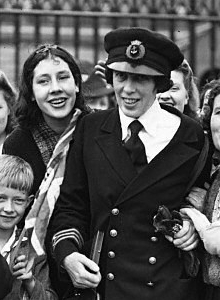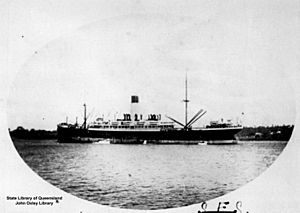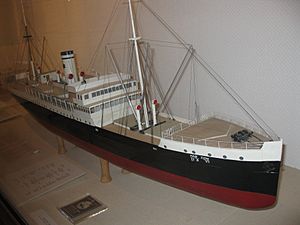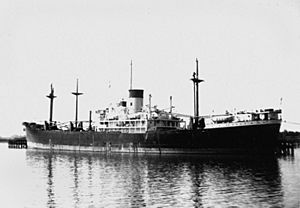Victoria Drummond facts for kids
Quick facts for kids
Victoria Alexandrina Drummond
MBE
|
|
|---|---|

Drummond after receiving her MBE, July 1941
|
|
| Born | 14 October 1894 |
| Died | 25 December 1978 (aged 84) Ditchling Common, East Sussex, England
|
| Resting place | Megginch Castle, Scotland |
| Occupation | Marine Engineer |
| Known for | First woman marine engineer in the UK |
| Parent(s) |
|
| Relatives |
|
| Awards |
|
Victoria Alexandrina Drummond (14 October 1894 – 25 December 1978) was an amazing woman. She became the first female marine engineer in the UK. She was also the first woman to join the Institute of Marine Engineers. During World War II, she worked as an engineering officer in the British Merchant Navy. She even received awards for her bravery when her ships were attacked.
Contents
Early Life and Dreams
Victoria Drummond was born on 14 October 1894 in Errol, Perthshire, Scotland. Her father, Captain Malcolm Drummond, worked for Queen Victoria. Her mother, Geraldine Margaret Tyssen-Amherst, came from a well-known family.
Victoria had two older sisters, Jean and Frances, and a younger brother, John. Queen Victoria herself was one of Victoria's godmothers. The children grew up learning to work hard. They sold vegetables, flowers, and even butter that Victoria made by hand. Their family faced financial difficulties when their grandparents lost a lot of money in 1906.
Victoria loved to build things. She became a prize-winning model maker, creating her own toys. These toys were shown in exhibitions and won awards. She often visited Robert Morton and Sons, an engineering company in Errol. They built engines for trucks and buses. As a young girl, she asked Mr. Morton how she could become a marine engineer and go to sea. He told her she needed to complete an apprenticeship.
Starting an Apprenticeship
In 1915, Victoria turned 21. Her father encouraged her to choose her own career. She decided to follow her dream of becoming a marine engineer. On 18 October 1916, she started her apprenticeship at the Northern Garage in Perth. In her first year, she earned three shillings a week. After deductions, she took home half a crown. Her foreman, Mr. Malcolm, had worked on ships and supported her training. She also took maths and engineering classes three evenings a week.
In 1918, Mr. Malcolm was dismissed from the garage. Victoria decided it was time to move on too. Her father helped her get a job at the Caledon Shipbuilding & Engineering Company in Dundee. She started by making patterns for metal parts. In 1919, she moved to the finishing shop. She joined the Women's Engineering Society. In 1920, she finished her apprenticeship and became a graduate of the Institute of Marine Engineers. She continued working at Caledon as a skilled worker. Later, she moved to the drawing office. In 1922, Caledon had fewer orders and had to let many workers go, including Victoria.
First Years at Sea
While at Caledon, Victoria was promised a job as an engineer at sea by Henry Wortley, a director of Blue Funnel Line. When Caledon laid her off in 1922, Victoria contacted Blue Funnel. Lawrence Holt, another director, honored the promise. He invited her for an interview in Liverpool.
Blue Funnel hired Victoria to work in their engineering office in Liverpool. About a month later, on 25 August, she was told to join the passenger ship Anchises for a trial trip. On 2 September, she officially signed on as Tenth Engineer. She earned £10 a month. She worked on Anchises until 1924, making four trips to Australia and one to China.
Most of the crew and officers on Anchises accepted having a woman engineer. However, some women passengers made rude comments. The ship's usual Second Engineer, Malcolm Quayle, supported Victoria. They became good friends. In 1924, Victoria wanted to take her exams to become a Second Engineer. She left Anchises and Blue Funnel in April 1924.
Becoming a Second Engineer
Victoria began studying for her Second Engineer's qualification. In October 1926, she passed her exam. She became Britain's first certified woman marine engineer. However, finding work was still hard. She could only find a job as a Fifth Engineer. On 14 April 1927, she joined the British-India Steam Navigation Company ship Mulbera. She worked on this ship until 4 December 1928, making trips to East Africa, India, and Ceylon.
On Mulbera, most of the crew accepted Victoria. But the Second Engineer, Mr. Lamb, did not want her there. Victoria said he often shouted at her. She nicknamed him "The Tiger." Despite this, Victoria did her job well. She even won over passengers who doubted a woman could be a marine engineer.
Twelve Years Ashore
From 1929, Victoria and her sister Frances lived in a house in London. They started a business called Golden Fisheries, selling goldfish.
From October 1929, Victoria tried many times to pass the Board of Trade examination for Chief Engineer. Each time, she failed. In 1936, her old teacher, Mr. Martin, spoke to the examiners. They admitted they always failed her because she was a woman. They even failed other candidates who took the exam with her to avoid looking unfair.
In March 1938, Victoria and Frances were at a trade fair in Vienna. German forces occupied Austria during the Anschluss. Victoria described this time as tense and dangerous. After this experience, they helped several Austrian children come to the UK as refugees. They found schools and homes for them and paid their expenses for a year.
World War II Service
In 1939, war seemed certain. Victoria applied to return to sea as a Second Engineer. Despite her excellent service and strong references, all her applications were turned down. So, she joined her sisters as Air raid wardens in Lambeth, London.
Serving on Har Zion
Victoria then went to the Royal Docks to find a ship. A sailor she knew from 12 years earlier recognized her. He suggested she try a foreign ship if British companies wouldn't hire her. He introduced her to a representative from Palestine Maritime Lloyd. This company was owned by Jewish businessmen in Haifa, Palestine. They hired her as Second Engineer on their ship, the 2,508 GRT Har Zion.
Har Zion was an old ship in poor condition. Victoria managed the engine room crew and helped repair the ship in Antwerp. The ship carried cargo and passengers. It evacuated British people from Marseille to Gibraltar. In July 1940, Victoria left the ship because of a difficult Third Engineer. About a month later, Har Zion was sunk by a German submarine, with almost everyone on board lost.
Bravery on Bonita
In August 1940, a Panamanian company hired Victoria for their cargo ship Bonita. She joined the ship in Fowey in Cornwall. Bonita was a neutral ship, so it did not travel in a convoy.
On 25 August 1940, while in the North Atlantic, German aircraft attacked Bonita. Victoria was on watch in the engine room. Bombs exploded near the ship, damaging pipes and causing fuel oil to leak. Victoria stayed alone at her post. She managed to increase the ship's speed from 9 knots to 12.5 knots in just 10 minutes. This extra speed helped the captain steer away from the bombs. The attack lasted 30–35 minutes. Bonita survived and reached Norfolk, Virginia on 8 September.
The First Mate, Mr. Warner, described Victoria as "about the most courageous woman I ever saw." The captain also praised her as "one of the most competent engineers." For her bravery, Victoria was awarded the MBE and the Lloyd's War Medal for Bravery at Sea in July 1941. King George VI presented her with the MBE.
More Wartime Voyages
In February 1941, Victoria joined the old Panamanian steamship Czikos as Second Engineer. While sailing to the UK, a German aircraft attacked the ship. Bombs missed, but machine-gun fire hit the ship, killing one crew member and wounding two others.
In April 1942, Victoria joined Manchester Liners' Manchester Port as Fifth Engineer. The ship was dirty and the food was bad. However, it led a convoy to North America. The ship survived the trip and returned to Liverpool.
In August 1942, Victoria joined the cargo steamer Danae II as Second Engineer. She called it "The worst ship I ever sailed in." The ship's managers tried to fire her, but the crew refused to sail without her. Victoria reported the ship's poor management.
At the end of January 1943, Victoria returned to Blue Funnel. She worked as a refrigeration engineer on the refrigerated cargo ship Perseus. She sailed around the world, visiting places like New York, Australia, and South Africa. In July 1943, she visited Cape Town and saw her friend Malcolm Quayle's grave.
In April 1944, Victoria joined the diesel oil tanker Karabagh as Assistant Engineer. She sailed on an Arctic convoy to the USSR. After D-Day in June 1944, the tanker carried supplies like aviation fuel across the English Channel for the Invasion of Normandy.
Post-War Years and Retirement
After the war, Victoria's home was damaged by bombs. In 1945, she and her sisters moved to a new flat in London. In April 1946, Blue Funnel sent Victoria to supervise the building of two new ships, Rhexenor and Stentor, in Dundee.
Victoria passed her Second Engineer's motor examination in May 1946. In September, she returned to sea as Second Engineer for Cunard-White Star Line. For the next four years, she worked as Chief or Second Engineer for various shipping companies.
In February 1952, Victoria returned to Scotland to supervise the building of the Master Nicos. She would have liked more such jobs. Instead, she was offered a position on the Markab. She worked on Markab as Second Engineer, then as Chief Engineer, for a year-long voyage. This trip took her through the Suez Canal, to Japan, Hong Kong, Singapore, the Mediterranean, the US, the Caribbean, and South America.
Victoria continued to work for various shipping companies for short periods. In April 1957, she joined the British Monarch for a six-month voyage. This journey took her across the Atlantic to the US, through the Panama Canal, across the Pacific to Japan, and back.
In May 1958, she worked as an engineer on an old motor yacht, My Adventuress, sailing from Southampton to Istanbul. The engine was unreliable, and she did not get along with the owner. After this, she stayed ashore for a year.
Final Years at Sea
Victoria spent her last three years at sea as a Chief Engineer for the Jebshun Shipping Company of Hong Kong. Her first Jebshun ship was the Grelrosa, which she joined in July 1959. The ship needed a lot of work to pass its inspection. Grelrosa sailed to Japan, China, and Hong Kong, where it was renamed Shantae.
In February 1960, while in Bangkok, Shantae loaded a mixed cargo that was packed carelessly. On 1 March, a fire started in one of the holds. Victoria used steam to try and put out the fire. Shantae reached Hong Kong on 3 March, where the fire was finally put out.
Victoria's next Jebshun ship was the Shun Fung, which she joined in September 1960. This was another old steamship that needed repairs. She served on it for 14 months, sailing to Japan, China, West Africa, India, and Singapore.
Her final ship was the Santa Granda, which she joined in November 1961. Victoria found the ship in very poor condition. A vital safety part was missing from the engine. The ship loaded iron ore and soon began taking on water. On 13 December, Victoria and the captain found serious damage in one of the holds. The ship was in danger of sinking. They managed to get the ship to port for repairs. Victoria argued with the company to make sure all necessary repairs were done. On 30 March 1962, she left the ship and retired.
Victoria and her sisters lived together in London for 12 years. She wrote her life story. In the early 1970s, Victoria became less mobile. In 1974, she broke her leg and went to the hospital. Soon after, her two sisters also went to the same hospital and passed away. Victoria recovered physically but her mental state worsened. She moved to a nursing home in East Sussex. She passed away there on Christmas Day 1978. She is buried at Megginch Castle with her family.
Over her 40-year career, Victoria made 49 ocean voyages. She faced many challenges and some unfair treatment because she was a woman. However, she was accepted and supported by most of her fellow officers and almost all the crew members.
Remembering Victoria
- There is a Victoria Drummond Room at the IMarEST headquarters in London.
- Her niece, Cherry Drummond, 16th Baroness Strange, wrote her biography called The Remarkable Life of Victoria Drummond – Marine Engineer.
- In 2013, Victoria was part of an exhibition called 'Women in Science' at the National Library of Scotland.
- Abertay University has a blue plaque on its Old College building to remember her time training there.
- In 2018, she was added to the Scottish Engineering Hall of Fame.





